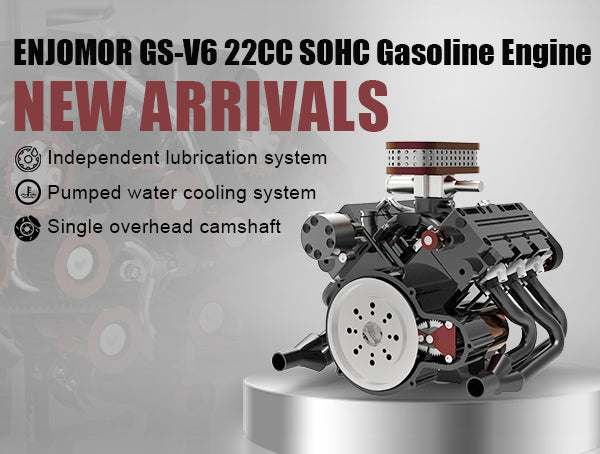
ENJOMOR GS-V6 Released | EngineDIY
ENJOMOR GS-V6 Engine Details PDF
Engine Introduction
Welcome to the presentation of the V6 Mini Engine Model, that meticulously represents the structure of a real V6 engine, offering an opportunity for automotive enthusiasts and students of mechanical engineering to understand and experience the workings of an engine.
Advantages of V-Type Engine
The term "V6" refers to the number of cylinders and the arrangement of cylinders in the engine. The advantage of this V-type arrangement lies in the coordinated operation of each cylinder, resulting in lower noise and smoother operation. Being shorter than an inline GSD6 four-cylinder engine and more compact than a GSV8. Compared to traditional inline 4-cylinder engines, the V6 offers better operational smoothness and consistent power output, aside from having two additional cylinders. This is achieved through the 90-degree angle design of the GSV6 engine, balancing forces on both sides of the crankshaft and canceling out its own vibrations, resulting in a smoother and quieter engine performance.


Key Specifications:
Displacement: 22cc
Maximum RPM: 9000
Maximum Power: 1.2kW
Starting Voltage: 12-18V
Piston Cylinder Diameter: 16.5mm
Crankshaft Stroke: 17mm
Output Shaft Diameter: 6mm
Dimensions: 123*125*102mm (LWH)
Fuel: 92#, 95#, 98# Pure Gasoline
Ignition Voltage: 8-12V
Engine Oil Type: 20w and Above
Engine Oil Capacity: 30-40ml
Total Weight: 2.1kg


1. Redesigned carburetor with a single needle for easier adjustment.
2. V-shaped six-cylinder four-stroke engine with SOHC single overhead camshaft.
3. Fully bearing-supported to reduce crankshaft torque and lower startup torque.
4. Oil mirror allows visual monitoring of oil level and condition for timely operational insights.
5. Air filter prevents foreign objects from entering the carburetor, avoiding ignition anomalies.
6. Timing belt ensures accurate timing of intake and exhaust valve operation by connecting to the crankshaft with a specific transmission ratio. Belt-driven for minimal noise, small variation, and easy compensation and replacement.
7. Wet cylinder liner for improved heat dissipation and uniform cooling.
8. Gear oil pump features strong self-priming capability, simple structure, even flow, and reliable operation.
9. Oil pipes serve as the lubrication system's arteries.
10. Distributor manages low-voltage circuit connection, producing high-voltage current for spark plugs in the designated ignition sequence. It's the ignition system's brain.
11. Flywheel and flywheel casing which accommodates the clutch assembly, connects to the transmission, acts as a power transmission pivot, and prepares for future derivative products.
12. Secondary gear reduces speed and increases torque, ensuring smoother electrical startup.
13. Spark plug, part of the ignition system, introduces high-voltage electricity from the distributor into the engine cylinder, creating sparks between the spark plug electrodes to ignite the air-fuel mixture, enabling normal engine operation.
14. Starter motor, the power source for electric starting.
15. Integrated exhaust for a richer engine sound, connectable to a muffler.
Analysis of 5C Component Processes
5C Component Showcase:
cylinderblock

cylinderhead

crankshaft

camshaft

connector

Cylinderblock Process: Lost-wax casting, CNC precision machining.



Crankshaft:
a. The crankshaft, a crucial rotating component of the engine, generally consists of main journals, connecting rod journals, crank throws, balance weights, front, and rear ends. The main journals, connecting rod journals, and crank throws form crank throws, with the GSV6 crankshaft having three crank throws.
b. In the mechanical processing of the model engine's crankshaft, rough machining typically involves multi-tool lathe turning of the main and connecting rod journals. This process often results in unstable material quality and significant stress, making it difficult to achieve proper machining allowances. Precision machining, involving rough grinding, semi-finish grinding, and polishing, is usually performed manually, leading to inconsistent processing quality and poor size consistency.
The GSV6 crankshaft's machining process employs: lathe turning and high-speed external milling for the main journals, high-speed external milling (preferably high-speed contour milling) for the connecting rod journals, all using dry cutting. During the contour grinding of the connecting rod journals, the crankshaft rotates around the main journal axis and grinds all connecting rod journals in a single clamp. In the grinding process, the grinding head oscillates reciprocally, following the eccentric rotation of the connecting rod journal, ensuring the crankshaft achieves appropriate machining allowances and stable processing quality.

Camshaft:
a. The camshaft controls valve opening and closing actions and drives the distributor. While the camshaft's rotational speed in a four-stroke engine model is half that of the crankshaft, it remains high and experiences significant torque. Consequently, the cam's strength and support are crucial in design. The GSV6 camshaft employs higher-strength stainless steel and features a full-support design with copper bearings for enhanced working efficiency.
b. Among the various parts and components of an engine, the valvetrain is of utmost importance. The camshaft, in particular, is the most crucial and pivotal component of the valvetrain. It determines the valve lift profile and valve timing, influencing the engine's intake and exhaust volume, and thus its power output. The GSV6 adopts a single overhead camshaft (SOHC) configuration, a top-mounted valvetrain design. The primary reason for this is that engines with top-mounted valvetrains can use higher compression ratios. SOHC, due to the absence of pushrods and rocker arms, reduces the inertial forces of the valvetrain, minimizing valve flutter tendencies. Moreover, the smaller motion range of SOHC allows for steeper cam profiles, enabling quicker valve opening and closing, with more time spent at full-open position. This improves engine breathing, enhances volumetric efficiency, and thus boosts engine performance, especially at high speeds.

Engine Highlight Sections
Product Highlights - SOHC (Single Overhead Camshaft)
SOHC: Stands for Single Overhead Camshaft engine, where the intake and exhaust valves' rocker arms are arranged together on a single camshaft. With a relatively simpler mechanical structure, easy to maintain, with lower fuel consumption and good durability. It offers strong torque at low speeds.
DOHC: Stands for Double Overhead Camshaft engine, with separate camshafts for intake and exhaust valves. DOHC offers higher performance, smoother operation, and lower noise. However, due to its complex manufacturing process, it comes at a higher cost. Multi-valve DOHC engines allow more efficient combustion and better emission control compared to SOHC engines (though more complex to engineer).

Product Highlights - Independent Lubrication
a. An effective lubrication system is essential for a reliable machine. Dry metal-to-metal friction can increase power consumption, accelerate surface wear, and even lead to overheating due to generated heat. The purpose of a lubrication system is to continuously deliver an adequate quantity of clean oil at an appropriate temperature to the friction surfaces of all moving parts, forming an oil film between them, thereby reducing friction, power consumption, and wear to enhance engine reliability and durability.
b. Independent lubrication also adds to the realism of the model engine, allowing enthusiasts to better understand the engine's structure.

Product Highlights - Wet-Type Liquid Cooling
a. Difference between wet-type and dry-type cylinder liners: Cylinder liners that do not contact coolant water on their backside are called dry liners. Those in contact with coolant water are wet liners.
Wet-type liners offer advantages such as better heat dissipation, uniform cooling, and ease of replacement.

Product Highlights - Full Bearing Support
a. Full bearing support helps reduce friction on the crankshaft, lowering rotational torque and ensuring greater stability during high-speed crankshaft operation.
b. During high-speed engine operation, the crankshaft must endure tension from the pistons, significant thrust generated as the pistons move in their strokes, and the centrifugal forces due to the crankshaft's own high-speed rotation. In such scenarios, full bearing support provides robust backing for the crankshaft, preventing deformation and breakage.

Product Highlights - Alloy Cast Iron Piston Rings
In engine models, excluding piston rings sealed with rubber, piston rings are commonly crafted from machined iron rings. Rings produced using this technique tend to be deformed and lose roundness due to stress from machining, leading to weak elasticity, poor sealing, susceptibility to wear, and low thermal stability.
GSV6 invests in higher costs by adopting the same alloy cast iron process used in genuine engine piston rings. This involves 32 precise steps, including molding and casting, to eliminate the shortcomings of regular machined rings.


Comments
Leave a comment